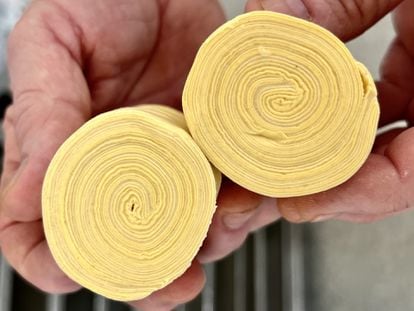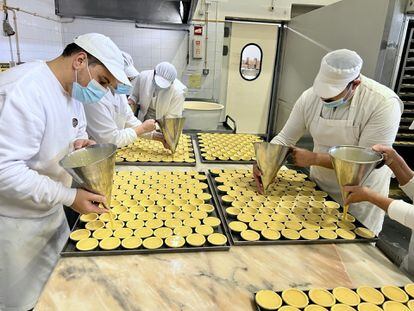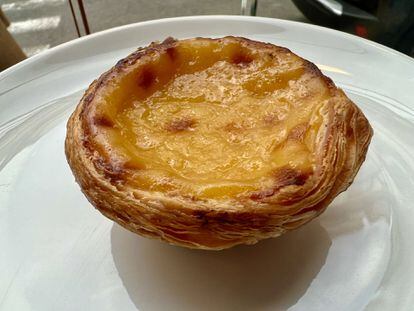I arrived in Lisbon with the craving to enjoy its typical pastels de nata and my first experience ended with a resounding failure. I was interested in those from Aloma, whose Instagram account promises unimaginable delights—O Melhor Pastel de Nata from Lisbon. 1st prize (3 editions)—and reality overturned my expectations. I was served two cold pastries, with the puff pastry chewy and the inner cream quite dry. By mid-afternoon it is possible that they had been in the windows of one of the brand's branches for hours and were not at all stimulating. Maybe on a bad day, fresh out of the oven, they would be much better, I thought at the time.
Pastels de nata, also called pastels de Belém, are not just anything. When well prepared and served warm, their three-inch diameter puff pastry tartlets with an intense butter flavor crunch like wafers, while the crème anglaise (eggs, milk, sugar and flour) with which they are filled offers a texture that in some cases it points to medium fluid. A real delight.
During my recent stay in the Portuguese capital, one of Europe's gourmet cities, I have not let a single day go by without tasting this icon of the neighboring country. Almost always en route through the pastry shops located in the Chiado neighborhood, some with long lines at the door and counters full of other excessively sugary traditional filigrees, heritage of a convent pastry of which Lisbon residents are proud. Pastry shops, in some cases, with visible workshops, where skilled workers mold the inside of the tartlets, fill them with cream and bake them before putting them on sale at prices that fluctuate between 1.40 and 1.50 euros per part.

Like almost all specialties that survive the passing of the years, pastels de nata are backed by a history with shades of legend. Without any document that confirms it, it is assumed that they were created in the 18th century by the Hieronymite monks of the Monastery of Santa María de Belém, on the outskirts of the Portuguese capital. No convents of nuns, nor delicate female hands, in this case men from a Catholic order who, between days of contemplation and long prayers, allowed themselves to be tempted by gourmand pleasures with a refinement that has survived the passing of the centuries. True or not, when the Portuguese liberal revolution (1820-1834) closed the monastery, it is said that the monk responsible for the bakery transferred the recipe to a certain Domingos Rafael Alves, who in turn would inaugurate the pastry shop. Pasteis House of Belém next to a sugar cane mill taking advantage of the secret recipe of those gluttons. It was 1837, a moment from which everything seems documented. The pastry shop remains open in the hands of the same family faithful to that recipe that today has been spread everywhere, proud of its daily success. To such an extent that they apparently make around 20,000 tartlets a day, figures that distance them from their artisan nature, no matter how proud they are of their bottom line.

After visiting several pastry shops and tasting several pieces at the counter, or in the company of some coffee sitting at one of their adjoining tables, I lean towards the pastries de nata from the Castro pastry shop, my big favorites. Very delicate, crunchy and soft, with a taste of butter and yolk, a danger in moments of craving. Why do some addicts add cinnamon powder at the last minute? Not only does it not improve its flavor, but it harms its particularly soft nuances. Matter of taste. Or traditions.
Before concluding my route I decided to contact an industrial workshop, Nortejo, which does not sell to individuals, on the outskirts of the city, determined to learn about the process that I had not been able to access in the artisan pastry shops. They showed me how to make his puff pastry blankets. Layers of flour and butter superimposed after undergoing repeated folding according to the well-known classic system. I witnessed the rolling of those sheets, a key aspect that transforms the horizontal puff pastry into long cylinders. Long tubes of dough that are cut into finger and a half slices, as if they were sausages, portions that are placed on the bottom of truncated conical bowls, flattened against their walls, filled with crème anglaise and entered into ovens where they are cooked. the puff pastry and brown the cream, which should be toasted and shiny, an important issue. I tried them and I liked them, so much so that they were in no way inferior to some of the ones I had alr
eady tried. I spoke with its owners, Dimas and Celso Ferreiro, and they told me about the export of these pastries that resist transportation once frozen. A project in which she is committed the Nata Lisboa-Bilbao companywhich already sells them in the Basque city and other cities around the world.

I do not doubt the value of this initiative, but cream cakes reach their peak when they are enjoyed warm, a few minutes after coming out of the oven.
ADDRESSES
#gourmet #route #Lisbon #eat #pastels #nata
